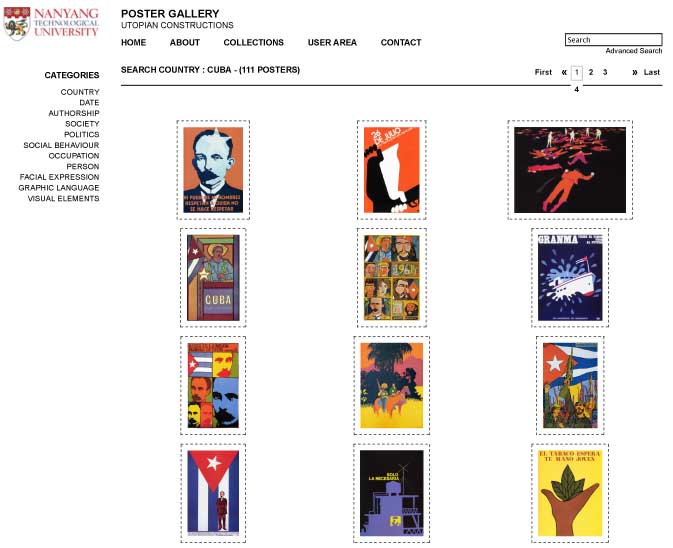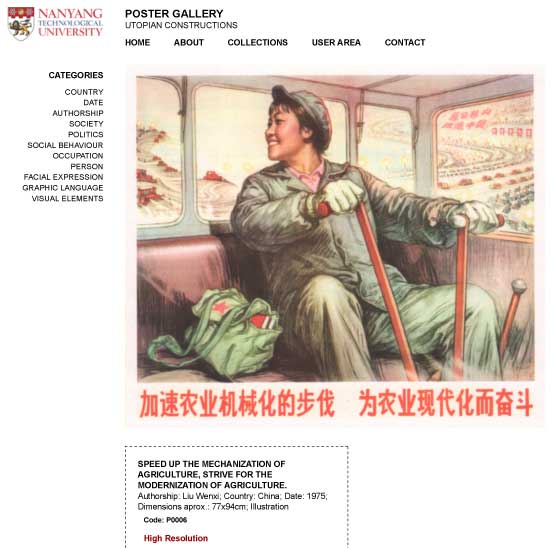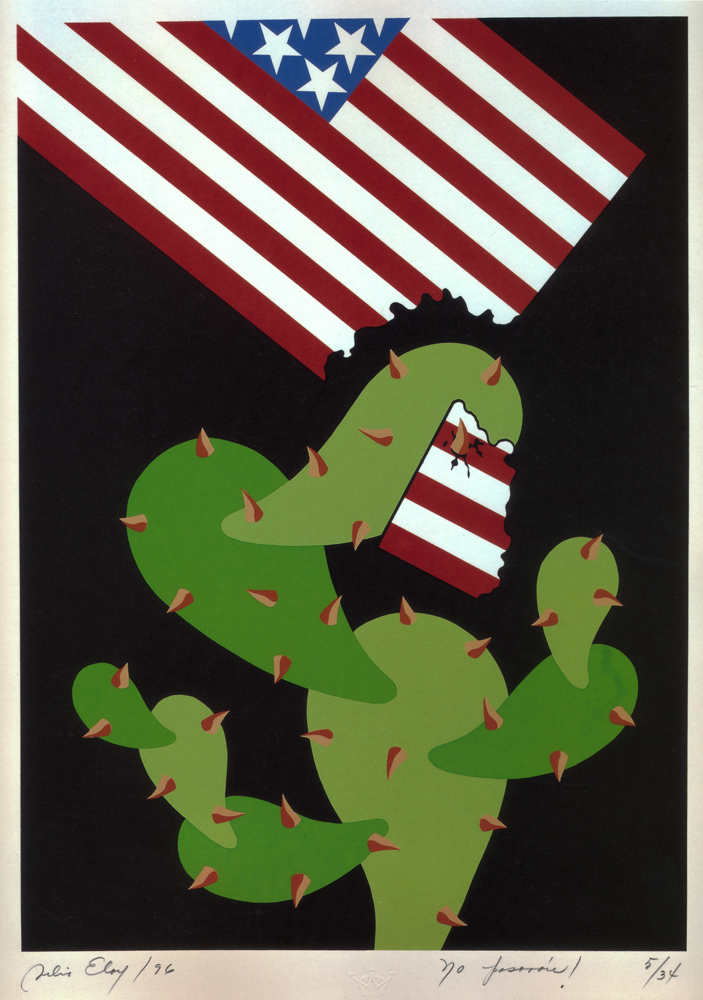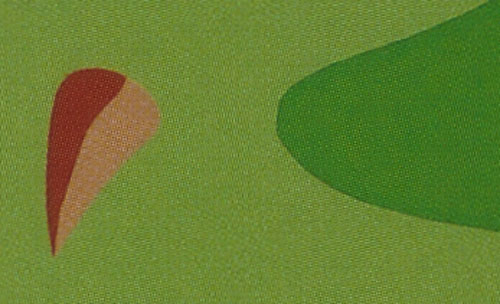Adventures in copyright violation:
The curious case of Utopian Constructions
Lincoln Cushing, Docs Populi - Documents for the Public
March 20, 2013
This article also appeared in Progressive Librarian, issue #41 Fall 2013
In November of 2012 I was prowling the Web for examples of political posters, one of my primary subject areas. I stumbled across a site that at first glance seemed quite rich with content and technological sophistication. But as I drilled down into it further my response went from surprise to shock. Scores, if not hundreds, of posters I had shot and published in books were loaded on the pages. To compound the problem, they were not just thumbnails, but high-resolution images. And none were credited to me – or any other source, for that matter.
The site was “Poster Gallery – Utopian Constructions,” a project of Nanyang Technological University in Singapore. Their “about” page described the poster archive project thusly:
“With a database of more than 5400 posters from many countries, a system of classification and search was developed which allows for the establishment of links and crossing references that lend higher complexity to the interpretation of this visual material of such great impact in recent history.”
After some initial clambering around the site for contact information about those responsible, I eventually reached professor Heitor Capuzzo in the School of Art, Design and Media, College of Humanities, Arts and Social Sciences. I told him of my concerns, and he assured me that he would take the complaint seriously and look into it. I turned to detailing the extent of the damage, and as far as I could tell the site was using 73 poster images from my book Revolucion! Cuban Poster Art (Chronicle Books, 2003) and 90 poster images from Chinese Posters: Art from the Great Proletarian Cultural Revolution (Chronicle Books, 2007) for which I was the co-author and responsible for all image provision.
Dr. Capuzzo assured me that Singapore was a strict follower of international copyright laws, but the vendors who had provided the images had assured him that they were from legitimate archives in their respective countries. I then proceeded to exhaustively document each violating image, noting the page in my book in which they appeared. In most cases there were large clusters where the image sequences were identical to those in my books. Further evidence included images that were composites (not a single actual poster) and, in the case of Chinese posters, identical English titles to those I had translated in my book. And finally, for the truly geeky about image technology, some of the images betrayed printed process color halftone dots for posters that have flat colors. The overwhelming evidence was that these were purloined images.
In the spirit of supporting an academic institution that had taken an unintentional wrong turn, I requested three things:
1. Credit as the source of the images, and additionally, credit to U.C. Berkeley’s East Asian Library, where the China poster collection now resides;
2. Removal of the high-resolution images; and
3. An explanation of the source of the images, so that I could try to stop this problem from happening again.
I had two partners in pursuing this complaint, my publisher and the East Asian Library. Both wrote letters supporting my case. Although Dr. Capuzzo agreed to the first request, he insisted on posting high-resolution images and did not have enough information to answer my third request.
In the digital world, there are almost no safeguards for images posted at high resolution. Aside from a robust, proprietary (and costly) digital watermark service like Digimarc, I had no way of proving that images were mine. And what’s even more distressing, I learned to my dismay that my photodocumentation was not protected.[i] Despite the years of experience and thousands of dollars I’ve invested in properly shooting large format documents, it’s still considered mere “copy photography” in the eyes of copyright law. The only way to protect my work, and that of the original artists whose work I handle, is to avoid public access to high-resolution images. The thousands of political posters I’ve shot that are appearing on the digital archive of the Oakland Museum of California are all presented in a way that allows a viewer to see details and fine type but not download a full image.
My saving grace was that these were all copied old school style – scanned from a published book. International copyright frowns seriously on such behavior, and academic institutions usually avoid trampling intellectual property rights. The eventual settlement was that they removed all of the violating images, and I am still awaiting any news of their investigation regarding image vendors. I’m not holding my breath. My experience is that people generally don’t like news that puts them in a bad light, and I’m unlikely to ever know what actually happened.
The Web giveth and the Web taketh away. If these copies had appeared in a local database, I never would have known about them. On the other hand, the risk of any actual “harm” to my work would have also been minimal. Putting the full fruit of one’s labor on the Web for all to use may seem liberating, but when it’s someone else’s labor the ethics get much more cloudy. I “protect” my work in order to avoid exploitation, not to limit public access. Archives and special collections are headed into uncharted territory. Examples such as Utopian Constructions reveal that we need to be vigilant, respectful, and creative.
UPDATE:
In June 2017 I was informed
that NTU carried out an extensive investigation into Dr. Capuzzo's
professional misconduct and other related matters. As a result, Dr.
Capuzzo is no longer employed by NTU. I understand it was never
determined where Dr. Capuzzo got his digital files, and he never
promised to not use them improperly in the future. Vigilance remains
the watch word.
Page updated 4/23/2021
[i] For an excellent exposition of this, see “The Complications of "Bridgeman" and Copyright (Mis)use,” by Katherine L. Kelley, Art Documentation: Journal of the Art Libraries Society of North America, Vol. 30, No. 2 (Fall 2011), pp. 38-42.

Screenshot of sample Cuba poster selections
- all from my book  Sample of individual China poster, from my book
Sample of individual China poster, from my book

Cuban screenprint by Julio Eloy, posted on Utopian Constructions at 350
dpi 11"x7.8" 
Detail of poster above, revealing printing solid field of color as CMYK
dots- not RGB